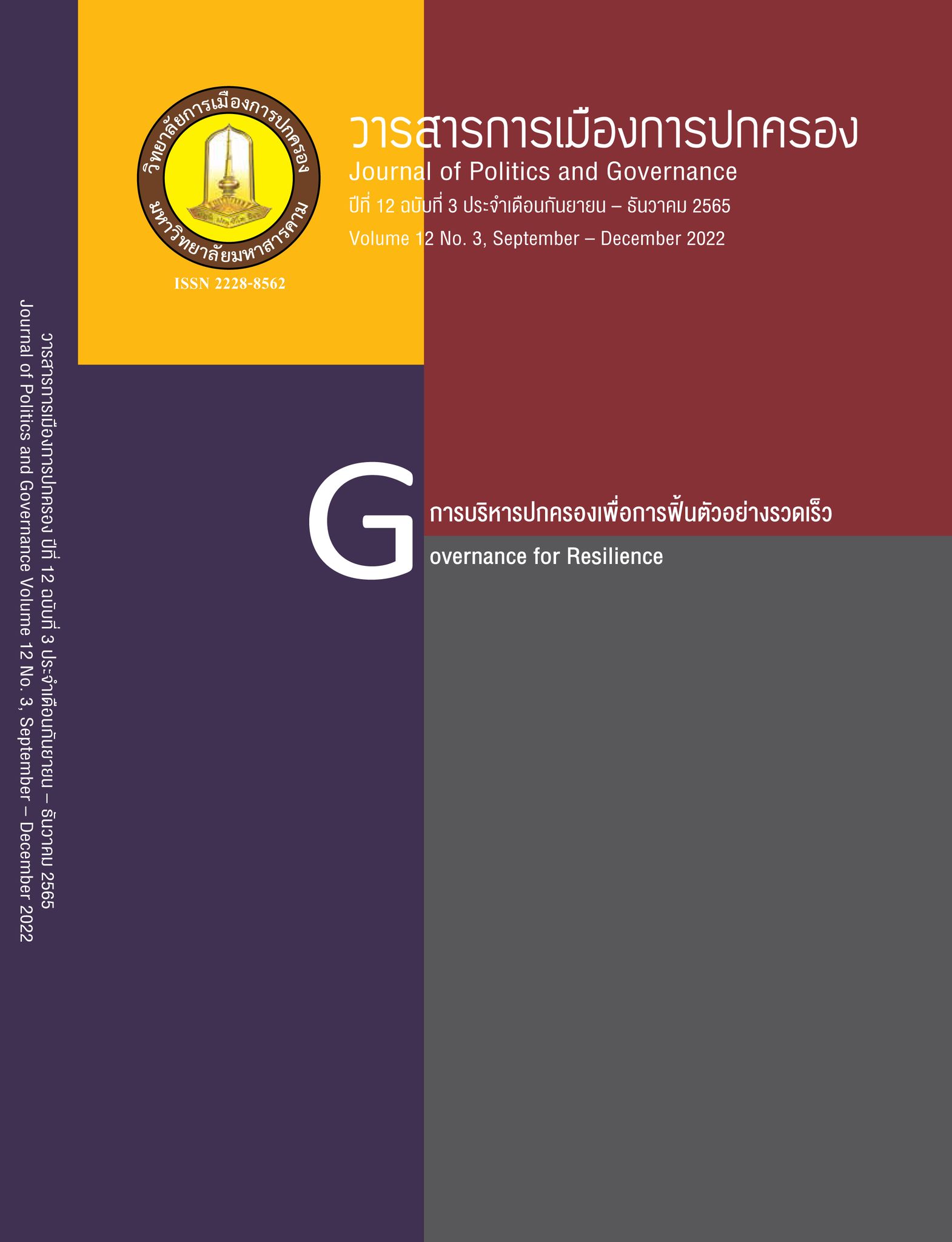Guidelines for the Development of System and the Potential of Dispute Mediation of the Agency Operating Dispute Mediation in Accordance with the Dispute Mediation Act B.E. 2562 (2019)
Main Article Content
Abstract
Dispute Mediation Act B.E. 2562 (2019), is a Central law that requires Government Agencies and the Public Sector to perform mediation procedures in the Same Format and Standards. But different potentials make the achievement of the objectives of the Law Different. This research aims to (1) study the System and the Potential of Dispute Mediation of the Agency Operating Dispute Mediated in Accordance with the Dispute Mediation Act B.E. 2562 (2019); and (2) to propose recommendations about the Development of System and the Potential of Dispute Mediation of the Agency Operating Dispute Mediated in Accordance with the Dispute Mediation Act B.E. 2562 (2019). The researcher conducted a qualitative method. By studying and analyzing the Dispute Mediation Act B.E. 2562 (2019) and related writings and in-depth interviews. Regarding the system and the potential of the Dispute Mediation agency, the research found that the Dispute Mediation Act B.E. 2562 (2019) stipulates the integrated system of the dispute meditation into 3 steps comprising: (1) upstream (2) midstream (3) downstream. It is collaboration among relevant groups of people including: the central government; the regional government; the judicial courts; the attorney general; the royal Thai police; and the public. The limitation of the capacity of meditators can be noted mainly due to lack of holistic body of legal knowledge. Then associated with the recommendations about the Development of System and the Potential of Dispute Mediation of the Agency Operating Dispute Mediation, the research revealed that:
(1) law related to qualification of the mediators should be amended;
(2) dissemination of law should be done;
(3) the curriculum of the specialized and professional skill for the meditators should be taken into account;
(4) the number of the community dispute meditation center and the registered meditators should be increased.
Article Details
References
เกษม คมสัตย์ธรรม. (2548). คู่มือประนอมข้อพิพาท. กรุงเทพฯ: สำนักงานคุ้มครองสิทธิและช่วยเหลือทางกฎหมายแก่ประชาชน สำนักงานอัยการสูงสุด.
ฉันทนา เจริญศักดิ์. (2557). รูปแบบการพัฒนาสมรรถนะของผู้พิพากษาในศาลแรงงาน. (ดุษฎีนิพนธ์ปรัชญาดุษฎีบัณฑิต ไม่ได้ตีพิมพ์). มหาวิทยาลัยรามคำแหง, กรุงเทพมหานคร.
ชลากร เทียนส่องใจ. (2553). การเจรจาไกล่เกลี่ยคนกลางเชิงพุทธ: หลักการและเครื่องมือสำหรับการจัดการความขัดแย้ง. (วิทยานิพนธ์หลักสูตรปริญญาพุทธศาสตรดุษฎีบัณฑิต ไม่ได้ตีพิมพ์). มหาวิทยาลัยมหาจุฬาลงกรณราชวิทยาลัย. พระนครศรีอยุธยา.
ชัยพร สมบุญวงค์. (2550). ระบบทวิภาคีในศาลแรงงานกลาง : กระบวนทัศน์ใหม่ของการไกล่เกลี่ยคดีแรงงาน. วิทยาลัยการยุติธรรม สำนักงานศาลยุติธรรม หลักสูตรผู้บริหารกระบวนการยุติธรรมระดับสูง (บ.ย.ส.) รุ่นที่ 10.
ทรงภพ ศรีโสภา เพ็ญศรี พัทธ์วิวัฒนศิริ และรุ่งนภา ตั้งจิตรเจริญกุล. (2562). การพัฒนารูปแบบการไกล่เกลี่ยข้อพิพาทคดีแรงงานในศาลแรงงานกลาง. บัณฑิตวิทยาลัย มหาวิทยาลัยสวนดุสิต, 15(1), 1-16.
ธัศฐ์ชาพัฒน์ ยุกตานนท์, บรรพต วิรุณราช, และภัทรี ฟรีสตัด. (2560). แนวทางการพัฒนาศักยภาพผู้ประนีประนอมในศาลยุติธรรม กรณีศึกษา: ศาลแรงงานภาค 2. วารสารวิชาการคณะบริหารธุรกิจ มหาวิทยาลัยเทคโนโลยีราชมงคลธัญบุรี, 12(2), 17-32.
พระราชบัญญัติการไกล่เกลี่ยข้อพิพาท พ.ศ. 2562, ราชกิจจานุเบกษา ฉบับกฤษฎีกาเล่มที่ 136 ตอนที่ 67 ก, (22 พฤษภาคม 2562), 1-21.
มะรอนิง สาแลมิง, และคณะ. (2554). การไกล่เกลี่ยข้อพิพาทครอบครัวและมรดก ตามบทบัญญัติศาสนาอิสลามในจังหวัดชายแดนภาคใต้. สำนักนโยบายและยุทธศาสตร์ สำนักงานปลัดกระทรวงยุติธรรม กระทรวงยุติธรรม: กรุงเทพมหานคร.
ระเบียบกรมคุ้มครองสิทธิและเสรีภาพ ว่าด้วยการไกล่เกลี่ยข้อพิพาทของศูนย์ไกล่เกลี่ยข้อพิพาทภาคประชาชน พ.ศ. 2562, ราชกิจจานุเบกษา ฉบับกฤษฎีกาเล่มที่ 136 ตอนพิเศษที่ 297 ง, (3 ธันวาคม 2562), 3-17.
ระเบียบสำนักงานศาลยุติธรรมว่าด้วยการไกล่เกลี่ยข้อพิพาทตามกฎหมายว่าด้วยการไกล่เกลี่ยข้อพิพาท พ.ศ. 2562.
สำนักระงับข้อพิพาท. (2550). คู่มือการระงับข้อพิพาทสำหรับประชาชน. กรุงเทพฯ: จิรรัชการพิมพ์.
อภิชัย ไทยเที่ยง. (2548). คู่มือประนอมข้อพิพาท. กรุงเทพฯ: สำนักงานคุ้มครองสิทธิและช่วยเหลือทางกฎหมายแก่ประชาชน สำนักงานอัยการสูงสุด.


